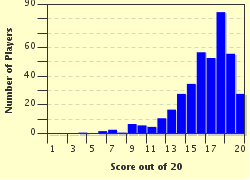Quiz Answer Key and Fun Facts
1. Well, let's start off kind of laid back, since that's pretty much how the decade began. It was a more innocent time, and the music was also less full of angst and agony.
Or was it?
What absolute tear-jerker of a song did pop musician Ray Peterson "cry" about in his U.S. number seven hit way back in 1960?
2. Ernest Evans, enjoyed great success with "The Twist" in 1960, a tune written by Hank Ballard, although the songwriter had actually written and recorded the song himself the previous year. His group had seen it make its way to only the number 28 slot on the charts the previous year, but Ernest saw it shoot all the way to number one.
By what stage name do we know Ernest Evans?
3. This music artist not only collaborated in the writing of this major hit of 1961, he also sang it. A few of the lyrics follow:
"As I walk along, I wonder
A-what went wrong with our love
A love that was so strong.
And as I still walk on, I think of
The things we've done together
While our hearts were young"
Who recorded the hit song "Runaway" in 1961?
4. In 1961, Bobby Vee released a tune that had been written by Carole King and Gerry Goffin. This mega-hit took off like a rocket, and wound up at the top of Billboard's Hot 100 chart in September of that year, while also charting at number three in the U.K.
Do you recall the name of this immensely popular tune that seemed to imply that someone else should take charge?
5. U.S. involvement in a faraway place called Vietnam was gradually increasing, and while this song did not address any particular complaint about the war,
(that came later in the decade), it did have a certain appeal to those who cared about their acquaintances in the U.S. military.
What was this hit sung by The Shirelles, that topped the Billboard Hot 100 charts in 1962?
6. Another hit song from 1962 was "Johnny Angel" by Shelley Fabares. The tune expressed a longing on the part of a girl who was infatuated with a young man who didn't even know she existed, and the song reflected her unrequited love for him.
On what popular '60s television program did she first perform this number two hit single?
7. Singer/songwriter Barry Mann and his wife, Cynthia Weil, wrote a hit song for Eydie Gormé, who scored big with it in 1963.
With what song featuring a Brazilian beat did Eydie top the charts?
8. In 1963 the British successfully invaded the U.S. (at least on the music charts). The Beatles fared extremely well on the U.S. charts with their lilting tune "She Loves You" on September 16 of that year, and Beatle-mania was here to stay for the remainder of the decade.
What is *incorrect* about the above statement?
9. Onward ho, to Nineteen Hundred Sixty and Fo'!
Following the evolutionary nature of this quiz, what could be more appropriate than to note that, "The Times They Are A'Changin'" - at least according to this singer in 1964?
What American musician saw this song climb up the U.S charts to number 20, in spite of a lack of enthusiasm by a few critics and some of his fans?
10. Wow! Who wrote or sang this song in the first place?
So many people did so many variety of versions of it under different names, and so many places lay claim to its origins that no one may ever know!
A song about a location in New Orleans, Louisiana, "The House of the Rising Sun" became a huge number one hit for The Animals in 1964 in the UK, the US, and in Sweden, Finland, and Canada.
Who was the lead singer for the group?
11. Well, here we are in 1965, and singer Dusty Springfield's brother Tom wrote a hit song for an Australian group called The Seekers: "Georgy Girl". This song was featured in a film by the same name.
12. 1965 was a banner year, with hits by the Beatles and the Rolling Stones leading the pack. Also prevalent were songs with titles like "Hang On, Sloopy", "This Diamond Ring" and "Turn, Turn, Turn".
Can you name the three groups who put these tunes on the charts that year?
13. Patience is a virtue, according to this girls group in 1966, as they lamented the fact that "You Can't Hurry Love". Their version of the song eventually wound up being designated as one of The Rock and Roll Hall of Fame's "500 Songs That Shaped Rock And Roll" collection.
Which girl group was so honored in this manner?
14. Okay, I am NOT going to tell you who had a number one hit with this song in 1966, and I am NOT going to tell you the name of it. I will, however, tell you a bit about the lead singer and I will tell you the name of the American band that sang it the previous year.
Reginald Maurice Ball, (aka Reg Presley) pursued private interests in things like doing research into alien spacecraft, studying lost civilisations, alchemy (turning base metals into gold), and trying to determine the origins of crop circles.
Now, can you tell me the name of the tune and of the BRITISH band that scored a number one hit with this song that had previously been released by an American group called The Wild Ones?
Hint: Let's make everything GROOVY!
15. By 1967 the psychedelic sound of rock music was ubiquitous, permeating airwaves across the globe, and featuring music by The Beatles, The Rolling Stones, along with The Doors and countless other bands.
What group took us back (in a psychedelic manner) to a time when two books were written by Lewis Carroll in the late 1800s, with their hit song "White Rabbit" which was released on an album called "Surrealistic Pillow"?
16. You look as if you've just turned "a whiter shade of pale"!
Which psychedelic, anti-establishment musical group performed this memorable classic in 1967?
17. "In the white room with black curtains near the station -
Blackroof country; no gold pavements; tired starlings.
Silver horses ran down moonbeams in your dark eyes
Dawnlight smiles on you leaving, my contentment."
When the group Cream released the psychedelic song "White Room" in 1968, it almost instantly raced to the number one position on music charts in eight countries.
18. In 1968, a song that mentioned "heavy metal thunder" and told you to "fire all your guns at once and explode into space" became a huge hit for Steppenwolf, a band with roots in Los Angeles, California.
Which one of the following cuts from the album simply entitled "Steppenwolf" was it, that proved to be their greatest success?
19. John Fogerty, lead singer for Creedence Clearwater Revival (CCR) had a huge hit with this song in 1969, in which John recalled that he had "left a good job in the city, working for the man every night and day."
Which of CCR's singles was it that was released that year?
20. A medley that had actually been written for the 1967 musical "Hair" was released as a single in 1969, promptly rising to the top of the music charts in the U.S.
"Aquarius/Let The Sunshine In" proved to be immensely popular, peaking at number one for six weeks.
Who popularized this tune in 1969?
Source: Author
logcrawler
This quiz was reviewed by FunTrivia editor
agony before going online.
Any errors found in FunTrivia content are routinely corrected through our feedback system.

